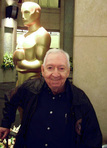Jack Fitzgerald's Blog, page 8
May 21, 2015
ENCORE: Spice Up Your Writing
Grammarians like to say Figures of Speech but I like to call them spices. I do that because I believer one should always add a little spice to one’s writing. Just as you do in cooking, seasoning brings out the flavor of your favorite dish. Spice can change the ordinary into the extraordinary.
Here’s how it works in a travel listing for example:
Charleston Place Hotel, Charleston SC.
(Without spice)
Thought by many to be the city’s best hotel, the place could use a few repairs. It is located downtown on King Street.
(With spice)
Viewed by many as the town’s grande dame. Although she could use a little Botox here and there, she sits right in the thick of things on King Street. (Condé Nast Traveler.)
Get the idea? This blog will present eight literary condiments for you to use. They can make all the difference in your writing.
1. METAPHOR: One thing is compared to another to show a similarity between the two. This spice isn’t just a writing adornment. It gives your reader a fresh way of viewing an idea or situation.
Ex: I’m a night owl and he gets up with the chickens. He falls in love at the drop of a hat. Her room is a pigsty. Life is a jungle. “It’s raining men here in Fort Lauderdale,” she said gleefully.
2. SIMILE: Just as with metaphors, one thing is also compared to another to suggest a similarity between the two via “like” or “as.” Similes make our writing more interesting and helps us to better visualize our subjects.
Ex. He is strong as an ox. She’s as big as the side of a house. She’s as pretty as a June rose. I felt like an elephant was sitting on my chest. She said my name like she was cooling soup.
3. HYPERBOLE: This spice is used in an exaggerated manner to emphasize a point you’re trying to make. This seasoning can make your writing more colorful, entertaining and interesting.
Ex. I was quaking from head to foot and could have hung my hat on my eyes, they stuck out so far. (Mark Twain, Old Times on the Mississippi), Your mama’s so FAT, after she got off the merry-go-round, the horse limped for a week.
4. ANTITHESIS: Stating contrasting ideas in a parallel arrangement of words, phrases, clauses or sentences.
Ex. Damned if she does; damned if she doesn’t. Ask not what your country can do for you; ask what you can do for your country. (John F. Kennedy), It was the best of times, it was the worst of times.” Charles Dickens, A Tale of Two Cities)
5. EUPHEMISM: Using a meek or obscure word or phrase as a stand-in for a disagreeable term. This is the language of avoidance, hypocrisy, prudery, and pretense. Euphemism is a good way to establish the personal nuances of the characters in your novel, screenplays, etc.
Ex. I’m afraid you’re being let go. (fired) He passed away in 2008. (died), Sleep together. (have sex) Portly or full-figured. ( fat) Break wind or pass gas. (fart) Powder your nose or go to the rest room. (toilet). The birds and the bees. (sex)
6. IRONY: The intended meaning is the exact opposite of the words used.
Ex. Clear as mud. As much fun as having a tooth pulled. I used to be Snow White but I drifted. (Mae West) Gentlemen, you can’t fight in here! This is the War Room. (film Dr. Strangelove)
7. OXYMORON: A unit of two words that are a complete contradiction to one another.
Ex. Random order, original copy, found missing, old news, deafening silence. Joe, if you’re gonna be a phony, you might as well be a real phony. How is it possible to have a civil war? (George Carlin), I’m an atheist, thank God. (Luis Buñel).
8. PUN: A double meaning is applied to a word or group of words; two words have the same or almost same sound but different meanings.
Ex. I’d love to go to Holland. Wooden shoe? What food these morsels be!” (slogan of Heinz pickles), Boo’s Liquor (East Terrell, Texas) Carl’s Pane in the Glass (glass and window services in Garland, Texas) C’est Cheese (cheese shop in Santa Barbara, California).
These 8 spices will do a lot to make your writing colorful, fresh and more interesting to your readers. Good writing!
May 7, 2015
Dialogue
Dialogue is the very essence and soul of writing whether it be in your novel, screenplay, stage play or short story. Basically you might say dialogue is conversation between people and most of the time it is used to solve a mutual problem. In real life you have both dialogue and talk. They are not the same. Dialogue is where information is passed between people. Talk is where you ramble on and mostly say anything that pops into your head.
Talk is forbidden in the world of professional writing. Even dialogue is different in real life and professional writing. In real life, for example, dialogue can contain a lot of uhs, aws, “likes” and clearing of the throat—all done in order to give you a moment to think of what you’re going to say next. In professional dialogue, uhs, aws and “like” are included only if the author puts them there for a purpose. In ordinary and daily conversation, just listen to how many people use the word “like” dozens and dozens of times. This word adds nothing nor does it reveal anything to real-life conversation. The word is just hanging there taking up space and time.
Good professional dialogue is memorable if it creates an eye picture in the mind of the listener. Then it’s like a song you can’t get out of your head. Bad dialogue is like a very powerful and effective sleeping pill in that it adds little or no forward movement to your plot.
If you hope to make it anywhere with your writing, you must be not only a good listener but also a good speaker. A good listener can quote what they’ve heard said long after the actual discourse has taken place. They can then incorporate it into their story telling. A good speaker knows how to articulate good dialogue.
Think of the last party or dinner you attended. It consisted of three types of people: spark plugs, sleeping pill people, or diarrhea mouths. Spark plugs are busy telling interesting stories that have a beginning, a middle and an end. Sleeping pill people either make one or two line comments or simply sit and listen with a grin on their faces. DMs can talk non-stop without saying much of anything. You’ll recognize them because they are “talking” which means they don’t have a beginning, middle or end to what they are saying. They are like a joke without a punch line. You usually excuse yourself and go refill your wine glass. Which of the three do you think could write an interesting book, screenplay, stage play or short story?
Dialogue in writing is not actual speech as though you were using a tape recorder. Good professional dialogue has to say a lot in the least number of words possible. So don’t think you can copy people’s words from a recording. What you use must give the voice of the person talking but it must move the plot forward. That means it has to be full of facts, important poop or a revelation of some kind that extends character or plot—or better yet, both.
Remember, dialogue works best when it’s short and straight to the point. Making dialogue conversational. believable and relevant can be difficult. One other small point. Characters shouldn’t constantly use the name of the person with whom they’re in conversation. Once or twice during a chat is quite adequate.
You never telegraph what is going to happen via your dialogue. Forbidden is to have someone use the phrase “going to.” You simply let things happen. Be sure to eliminate small talk unless it is part of the plot or for a very special reason. At parties or dinners you attend, “small talk” is where people speak and essentially are not saying anything or moving the plot of life along one iota. Living is in a standstill mode. That is not how soul mates meet at parties or dinners.
Conflict should be an integral part of scenes with professional dialogue because it is synonymous with plot. Without conflict, you’re just sitting there like a bump on a pickle. There has to be a push and pull—something that each character desires from the dialogue.
Advice on Writing Dialogue: First of all, determine if you are a spark plug, a sleeping pill or a diarrhea mouth. Maybe you don’t know. In that case, you’re going to have to ask someone. If you are a sparkplug, the only thing you have to work on is to make sure you add a lot of facts to what you have to say. Then study the paragraph below labeled Cadence and Beat.
If you are a sleeping pill, you’re going to have to make yourself become a storyteller at parties and dinners—or at least tell jokes. At any rate, anything you say must have a beginning, a middle and an end. Once you’ve awaken yourself enough to talk animatedly and tell a few jokes, you will be ready for the C & B paragraph below.
If you are a DM, you’ve got to shut up, stop clearing your throat so much, cut out the aws, uhs and interjecting the word “like “every other word. Practice at home telling an experience of yours and keep it down to fifty words. Make very sure you have none of that nothing word “like” and those guttural sounds you’re so fond of making. Once you see that people actually remain awake while you’re talking and don’t leave to go get another drink, you’re on your way to being able to check out the C & B paragraph below. Please make sure that you don’t laugh at your own jokes though or you’ll have to start your training program all over again.
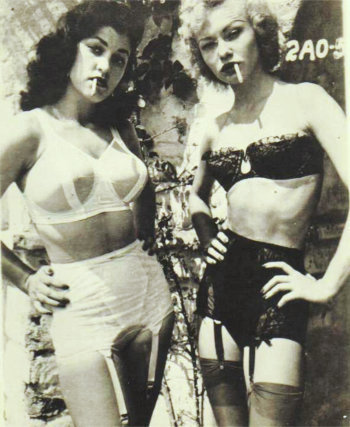
Cinderella and Sheila from the film “A Piece of Cake.”
Cadence and Beat. First of all, a review of linguistics. All words of more than one syllable have a unit in which the voice rises. That is called a stressed syllable. If the voice does not rise, it is called an unstressed syllable. All one-syllable words are unstressed. Most poetry and songs have cadence and beat. This means you want to snap your fingers in rhythm. You do this because your words have poetical meter due to the way you are using those stressed and unstressed units. Rhythm is when you can rely on a group of unstressed syllables in tandem with a stressed syllable in a repeated pattern. This is called meter. Shakespeare mainly wrote his plays in a meter called Iambic Pentameter. This means there are five beats to the foot. You measure a sentence by the number of feet it contains. These feet are the rhythm of your song, poem or spoken dialogue. Thus you have a beat and this gives your writing cadence. A funny thing about humans. We like beat and cadence not only in songs and poems but also in dialogue.
So, when you’ve written your dialogue, check it out for beat and cadence. Your meter doesn’t have to be perfect all the time. I personally write mainly with one stressed syllable every three to five units. That’s my meter. I’ve gotten into the habit of it so I don’t have to stay conscious all the time of what I’m doing.
BOTTOM LINE: Just make sure you have many, many more one-syllable words than you do two or more syllable words. You though should read your dialogue out loud and test it out for beat and cadence. You’ll know if your dialogue has rhythm just by listening to yourself read it orally. Southerners in the USA seem to have a natural proclivity for this and that’s one of the reasons why they’re so good at story telling—and why we have so many writers from the south.
Here is some dialogue from a screenplay of mine entitled A PIECE OF CAKE. The scene is a cheap porno shoot and the dialogue is between an experienced actress and a novice.
SHEILA: I’m so pleased to be working in a film with you, Cinderella.
CINDERELLA: Is that right?
SHEILA: Yes, I’ve seen all your films. I especially liked “Grope Therapy.”
CINDERELLA: So did the D. A. In fact, he told the judge there wasn’t a dry fly in the house.
SHEILA: I just can’t believe I’m going to be in a movie.
CINDERELLA: Neither can I.
So, read your dialogue out loud. Check for beat and cadence. Edit it if you don’t feel like tapping your foot.
Remember, good professional dialogue accomplishes various important effects. It reveals personality and provides tension. Also you will get rid of monotony if you vary your beat and cadence from character to character.
Note: If you have good beat and cadence, you have memorable dialogue. Also, go out and listen to people. It’s quite an adventure.
April 30, 2015
What if?
Recently I wrote a blog about a theater piece of mine called Yes Sir . The plot upon which the play was based incorporated a chance meeting I had with a woman in a bar in Laredo, Texas. When I wrote the play, I lifted most of the actual facts of her life and included them into the structure of the work. The stage play which resulted was called Maggie’s Way. I eventually changed characters around but the woman’s basic story remained the same.
As writers, we are lucky if life presents us with a basic plot intact. In the case of the preceding play, this was the case. I merely took life down in dictation. Of course one changes a few things but essentially the entire action of the play from Act I to Act III would be what one might call “dictation of life.” This does not just pertain to stage plays but to novels and screenplays.
I have been contacted quite a bit by aspiring writers for advice on how to get a project going—the latest request being just last week. I am always glad to help people and I will suggest certain things to them. For the most part, amateur writers (those who have yet to be paid for their work) tend to want to play it safe. They are great copiers. I, as I outlined in paragraph one above, was simply copying from life itself. However, the majority of budding writers I’ve communicated with want to write about the life of some public figure or copy some TV show or other work that has already made its mark.
To write about a public figure, unless you’re going to dig up a lot of heretofore unknown gossip, is going to be the blahs. This person’s life is already known and your retelling the story doesn’t present much fresh material.
The largest number of beginning writers try to imitate some already proven work—a gangster/cop show, a hospital situation , “Sex and the City” type stuff—even “Downton Abbey.” The most recent cry for help came from a young lady trying her version of a way-overbaked Italian crime family.
Many aspiring writers have not lived enough to have the necessary original adventures to translate into a work. They are busy recycling instead of creating new inroads. However, if you are lucky enough to have experienced some original adventures, your choice boils down to choosing from your exploits. Some are like I mentioned for my play Maggie’s Way—basically the entire plot is there intact. Those instances are rather rare. Usually your escapades point you in the direction of “What if….?” This means life presents you with a situation or set up but it’s up to you and your imagination to fill in the rest. Even so, you can turn a set up into a gold mine for yourself.
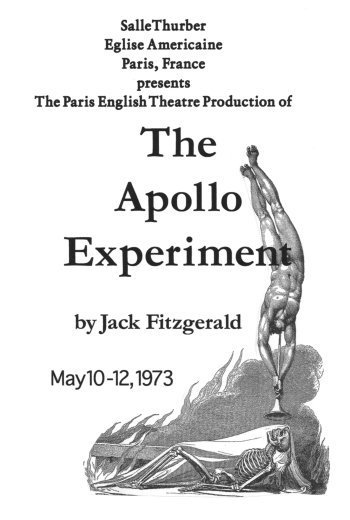 An example of “What if…?” for me was with my play THE APOLLO EXPERIMENT. After I finished my Master’s Degree at the University of Madrid, I applied to and was accepted as a professor of Spanish at New York State University, Plattsburg. After returning from Madrid, I moved to Plattsburg, a small town in northern New York State, which is 29 miles south of the Canadian border. The area was rather isolated and rental property was rare and very expensive due to its being a university town. I ended up having to rent a farm house outside in the country. This was nice in some aspects but very isolated. The people who rented me the place had a woman named Thelma to come and clean the place weekly. The first time she came, I was busy unpacking and she helped me take some of my things upstairs. She was a rather gruff woman and quite formidable.
An example of “What if…?” for me was with my play THE APOLLO EXPERIMENT. After I finished my Master’s Degree at the University of Madrid, I applied to and was accepted as a professor of Spanish at New York State University, Plattsburg. After returning from Madrid, I moved to Plattsburg, a small town in northern New York State, which is 29 miles south of the Canadian border. The area was rather isolated and rental property was rare and very expensive due to its being a university town. I ended up having to rent a farm house outside in the country. This was nice in some aspects but very isolated. The people who rented me the place had a woman named Thelma to come and clean the place weekly. The first time she came, I was busy unpacking and she helped me take some of my things upstairs. She was a rather gruff woman and quite formidable.
After being there a while, she looked out the window, then quickly went to the front door and yelled, “Robert, you leave them cats alone.”
She turned around and said as she lit a cigarette, “He’d just as soon wring their necks off as look at them.”
I asked, “Who’s Robert?”
She answered, “My boy Robert. He ain’t right if you know what I mean.”
I took a look out and there was a Neanderthal looking young man in his twenties. He would have been handsome except his face and body was scared and twisted. Thelma saw that I was shocked.
“His father collected used bottles and glass containers. One night while crossing Farrell Bridge south of town, he was carrying Robert and a bag of bottles on his shoulder. He was drunk and fell off the bridge. Roberts was all cut up and hit his head on a rock and ain’t been right since.”
I took another look at Robert. Every so often she would yell out at him. He would cower and was totally subdued.
Later I got to thinking about Robert and her and myself, the college professor who had just moved in. I came up with a very good “What if……?” situation based on Thelma and Robert. What if the professor living there was a psychology professor rather than an instructor of Spanish? What if he used Robert as a guinea pig and miraculously cured him and brought him back to normalcy? I began writing my play THE APOLLO EXPERIMENT based on Robert and Thelma. I let my imagination fill in the missing spots. Later via The Paris English Theatre, my play had its premiere production and was quite successful.
The thing is to check out experiences you have had and add a “What if….?” to them and see if you cannot come up with an intriguing play, book or screenplay.
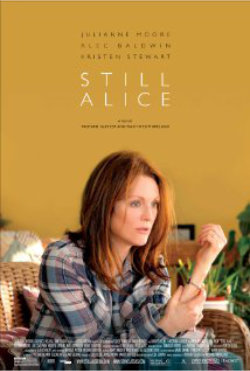 I recently read where Lisa Genova, an American Neuroscientist at Harvard, wrote a book about a Harvard professor who suffered from early onset of Alzheimer’s disease. The book was named STILL ALICE. This was for sure a “What if….?” plot based on some experience she had had. She sent the book to agents to try and get some interest but none was forthcoming. They all told her that the material was too depressing and people wouldn’t be interested. After being turned down over and over, she self-published the book in 2007. She worked tirelessly, getting her novel out to anyone who would read it. She finally got an agent who quickly sold it for six figures to Simon & Schuster publishers. They republished the book and before long it was on the New York Times Best Seller List. It was ultimately made into a film named STILL ALICE and the leading actress, Julianne Moore, won the Oscar this year for Best Actress.
I recently read where Lisa Genova, an American Neuroscientist at Harvard, wrote a book about a Harvard professor who suffered from early onset of Alzheimer’s disease. The book was named STILL ALICE. This was for sure a “What if….?” plot based on some experience she had had. She sent the book to agents to try and get some interest but none was forthcoming. They all told her that the material was too depressing and people wouldn’t be interested. After being turned down over and over, she self-published the book in 2007. She worked tirelessly, getting her novel out to anyone who would read it. She finally got an agent who quickly sold it for six figures to Simon & Schuster publishers. They republished the book and before long it was on the New York Times Best Seller List. It was ultimately made into a film named STILL ALICE and the leading actress, Julianne Moore, won the Oscar this year for Best Actress.
If you want to write and be unique, the first thing you must do is add some adventure to your life. Then you translate it to your writing project either as a basic plot or as a “What if…..?” Remember, don’t recycle. Get out there and live life and then write about it.
April 23, 2015
ENCORE: Film Noir
(This year’s Arthur Lyons Film Noir Festival in Palm Springs, CA will be held May 14 to May 17, 2015. I will be attending.)
This past week Palm Springs where I live hosted yet another one of its fabulous film festivals: The Arthur Lyons Film Noir Festival. This annual film lovers get together was founded fifteen years ago by the late Arthur Lyons, a lover of black and white films of the 1940s and early 1950s. The Film Noir Foundation has over the years chased down many of these largely-ignored films and returned them to newly restored 35mm prints.
Watching these great films of the past on the big screen is not only an appreciation multiplier but exactly how their creators had intended them to be seen. The festival itself is a unique assemblage of venerable stars, film biographers, fans dressed in era costumes and a general public all sharing their insights and recollections in a collaborative celebration of classic films.
The term Film Noir was coined by French critics to describe a type of film that is characterized by its dark, somber tone and a cynical, pessimistic mood. Literally meaning dark or black film, the term is derived from roman noir, a black or dark novel. Specifically, film noir describes those Hollywood films of the 40s and early 50s which portray the dark and gloomy side of life and many times focus on the underworld of crime and corruption. These films have heroes as well as villains who are cynical, disillusioned and often insecure losers. In terms of style and technique, the film noir basically abounds with night scenes, both interior and exterior, with sets that suggest dingy realism and with lighting that emphasizes deep shadows and accents a mood of fatalism.
Some of the film noir movies which showed this past week were The Window, Roadblock, Too Late for Tears, Sunset Boulevard, Sorry, Wrong Number, The Killers, Out of the Past and Laura.
Stars who attended were Barbara Hale (The Window), Nancy Olsen (Sunset Boulevard) and Terry Moore (Shack Out on 101.)
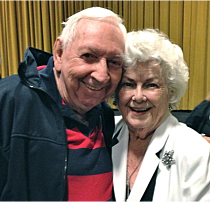
Barbara Hale and Jack after the showing of The Window.
I attended opening night with the showing of The Window starring Barbara Hale. This film was made in 1948 but was held up for release by its producer Howard Hughes for nearly two years. I had never heard of the film but like the rest of the audience found it excellent. It too benefitted from a restored print courtesy of The Film Noir Foundation. The Window also starred Arthur Kennedy, Bobby Driscoll, Ruth Roman and Paul Steward.
After the showing of the film, Barbara Hale was brought from the audience to the stage. She is a very pretty 93 year-old who is witty, charming and full of life. She discussed the film as well as her major career as Della Street of the Perry Mason series. She told the audience that she had not seen The Window in fifty-five years. She also said that she had no idea why Howard Hughes held up the release of the film. She noted that Mr. Hughes never interfered with films while they were being made. He apparently did that after they were completed by rarely releasing them promptly.
She spoke of Bobby Driscoll, the young actor who actually carried the film as he was on screen almost constantly. The credits said he appeared by special permission of Walt Disney. He had appeared in many Disney films including Song of the South. During the Q and A that followed, one audience member stood and said he had seen this film when he was a small boy and that he had developed a big crush on Bobby Driscoll. He wondered what had happened to him. She said it hurt her to relate that he had a very sad life, having been unable to find adequate work once he was an adult. He had overdosed on drugs in his early twenties and died. She added that for his role in The Window he had received a special Oscar for a juvenile performance.
Barbara spoke of Raymond Burr and her 9 years with that show. She said he was a practical joker and she never knew what trick he was going to play next. Several times she would come to work and find that her dressing room had been mysteriously painted a very strange color or that the floor had been covered with raw eggs which she stepped on in the dark. She also recounted that Earl Stanley Gardner who was the creator of the Perry Mason show could be difficult at times. Once she had to redo a scene because she leaned on Perry’s desk. He said he would never allow his secretary that liberty so the scene was done again.
Barbara was extremely gracious and seemed much younger than her 93 years. She spoke of her wonderful 36 years of marriage to actor Bill Williams and their son actor William Katt.
How amazing that one can go to an event like this Film Noir Film Festival and hook up with the past in such a splendid manner. I spoke with Barbara Hale afterwards and she couldn’t have been sweeter or nicer. What an evening. There was an opening night party to boot and all the good food and drink rounded out a perfect evening spent in the past.
April 16, 2015
Yes Sir!
A play is where you find it.
So many people have asked me from time to time how I came up with the idea for such and such a book or play. I never have to think very hard to answer them. All ideas I have used for any of my books, stage plays or original screenplays have arrived in my brain due to a real life experience of one kind or another.
Christmas of 1978 when I was living in Paris, my friend Ken and I decided to go spend the holidays with our good friend Erwin Leidel in Stuttgart, Germany. During that time, I became acquainted with the songs of a singer by the name of Zarah Leander (Featured Photo from her 1937 movie “La Habenera”). During World War II, she made many memorable musical films in Nazi Germany. Rumored to have been the mistress of Joseph Goebbels, the Propaganda Minister, she was the reigning queen of German cinema during the Nazi era. She didn’t make propaganda films per se but instead made just wonderfully photographed dramatic musicals peppered with party line half truths. (All of her films are available for purchase on the Internet.) After the war, she was chastised briefly for her collusion with the Nazi regime. As soon as possible after her reprimand, she took up her singing career once again.
Zarah Leander was an exotic brunette whose classic beauty made her dramatic singing voice extremely fetching. In the early fifties, she became the cult-darling of the Gays in Germany. They flocked to her concerts en masse and she kept singing to them even up into her eighties. Unfortunately in 1991, while performing a concert from her wheelchair in Vienna, she fell out of it onto the stage, broke her hip and thus ended her very lengthy and fabled career. She died not too long after that.
Before those Stuttgart Christmas parties, I had never heard of Zarah Leander myself. However, after seeing a couple of her movies on TV and listening to her songs, I must admit I became as fascinated with her as anyone else.
During our stay with Erwin, Ken, he and I took a weekend trip to Munich. In a small town about midway between Stuttgart and Munich, we stopped off at the home of a friend of Erwin’s by the name of Hermann, a jolly, rotund guy who was a super fan of the famed singer and who had opened his own private Zarah Leander museum. We spent the afternoon there and were amazed at how he knew every facet of her life. He had a vast collection of everything connected with the woman, including many programs and personal artifacts.
During our farewell party back in Stuttgart, one of Erwin’s friends Ingo presented me with an album of Zarah Leander’s songs from her wartime movies. Ingo told me he made sure it contained my favorite of her songs, Yes Sir!. I liked this number mostly because of its lilting, fast melody and because of the big production number connected with it in one of her films. The song actually made fun of John Wayne and how he was winning World War II all by himself—even though he actually never spent one day in military service. The song was far from vindictive and, so I was told by Hermann, was greatly appreciated by John Wayne himself after having upon an occasion met Zarah Leander .
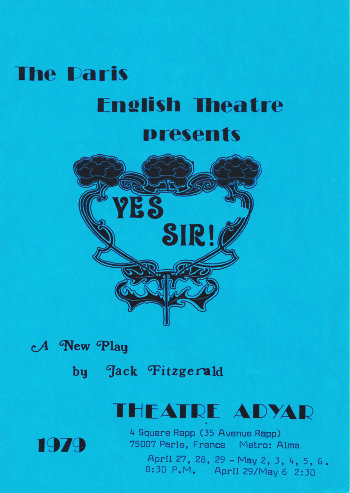 I knew instantly when Ingo gave me that album, I could feel a play coming on and I told him so. He was quite pleased and asked what the name of the play would be. I answered, “It can only be called Yes Sir!” Everybody had a good laugh and said they would surely come to Paris if I did write and produced Yes Sir! as a play.
I knew instantly when Ingo gave me that album, I could feel a play coming on and I told him so. He was quite pleased and asked what the name of the play would be. I answered, “It can only be called Yes Sir!” Everybody had a good laugh and said they would surely come to Paris if I did write and produced Yes Sir! as a play.
Ken and I got back home, picked back up with our routines and busily began the year 1979—my last year to live in Paris. In my quiet moments, on the metro, at lunch, before going to sleep at night, or at any odd moment, I reflected about Yes Sir!. I thought and thought about trying to come up with a play for that song title. The question was not a case of my muse having deserted me. I just didn’t know in which direction to guide my creativity.
One day I was cleaning out my closet and came upon some of my earlier amateur attempts at writing. One was a play I had written called MAGGIE’S WAY. It was based upon the experiences Ken and I had once had in a bar in Nuevo Laredo, Mexico—across the border from Laredo, Texas. He and I decided to go out for a drink in a local bar our first night there. We noticed the place had call girls fetchingly sitting around, waiting for the evening’s johns. One of the ladies I struck up a conversation with was called Maggie—short for Margarita.
We were having a lot of fun talking about life in general when this very handsome, young man came up. He smiled and said he hated to interrupt us but he had to talk to Maggie. They went off and after a lot of animated and friendly conversation, he left. Maggie rejoined us. I asked her who the young man was and she said he was her son. He was a student at the University of Texas School of Law and had just arrived home for the holidays. She said he just wanted to check in and inquire about what time she’d be home. She told us how nice he was, how proud she was of him, how she’d been a single parent and had to raise him the best way she could. She added proudly how she was helping him get through law school and that soon he was going to get married to a judge’s daughter in San Antonio.
I got back to our home in Riverside, California, and in the course of the next few weeks I wrote this play called Maggie’s Way, based on Maggie and her real-life situation. Eventually it got put away and via storage in different locations ended up in my closet in Paris, France.
I stopped and thought a long moment. It came to me that I was holding in my hands the play Yes Sir!. I didn’t know exactly how but I knew it was the general direction my muse had been waiting for. I took it over to my writing desk and somehow realized that Maggie’s real story as I had written it was true and valid—but not theatrical and original enough for a play in which music played a central theme. I ended up changing Maggie to a male drag queen in a bar and made a lot of other cosmetic changes to Maggie’s basic story. I even managed to work in the song Yes Sir! as a drag queen number.
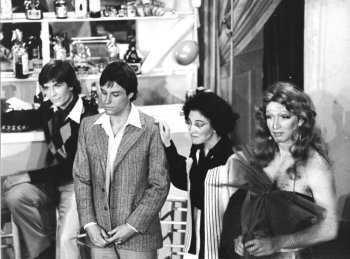
Scene from Paris English Theatre production of YES SIR!
When I finished with the new play, I contacted the members of The Paris English Theater and we had a reading. They wanted to go into production immediately. We did. We held auditions and were able to get some very top talent. We also got ourselves booked into the Théâtre Adyar, a lovely, large theater with a balcony not too far from the Eiffel Tower. We had enough patrons and donors to ensure that the production was first rate. So, that is how Maggie’s Way became Yes Sir! This proves that if you’re a writer, a play or a book is out there waiting for you to find it.
And yes, Ingo and Erwin and the other German friends (even Hermann) came for the Paris opening!
April 9, 2015
Sequels
A sequel is a work of literature, film or TV that continues the story or expands upon some earlier work. This type of narrative portrays events or people who have inhabited a previous work—usually in a chronological manner. Generally the follow up picks up on dangling plot points of the original and introduces new conflict to produce another allied story. In other words, the sequel continues elements of the original story with the same characters and settings. A sequel can lead to a series, a string of related productions.
Sequels are attractive to their creators because less risk is involved when you return to a story that has already achieved a certain amount of popularity. Sequels come about because their original setting, story or characters are already established. Audiences seem to like to revisit popular characters and settings. Publishers and film producers find sequels financially appealing because they are dealing with a product that has built in brand recognition. That’s like getting free publicity.
The most common sequels are movies where you will find already tested stories with well beloved characters attached. Sometimes the title has a number behind it or will be some variation of the original title. (Home Alone and Home Alone 2; Shanghai Noon and Shanghai Knights.)
A good bit of the time sequels do much more business than their predecessor. This reflects the already built-in publicity factor. Many times the sequel gets a rotten review but can still bring in more money than the original, which got great reviews. If a producer does the research and finds what elements led to a film’s success in the first place, all they have to do is recycle. This causes their chances of making money off of the sequel an almost done deal. If though, they change some major element around (actor, fictional character, location) they can lose money very easily.
All in all, film producers look at sequels as “hot” slot machines that pay off. Many of us have been to a casino and discovered a certain machine that is “hot.” It pays off time and time again. Are you going to change to another machine? No. That is why a film that makes a lot of money is immediately thought of as a “hot” property for a sequel.
Sometimes movie magic can happen in the world of sequels when people take long shots rather than betting on sure things. In 1992 Roberto Rodriguez made a film called El Mariachi for ten-thousand dollars. It was a hit and brought in two-million dollars. Its sequel Desperado came out three years later and brought in twenty-five million dollars.
The first Austin Powers film in 1997 brought in fifty-three million dollars but its sequel Austin Powers: The Spy Who Shagged Me brought in well over two-hundred million dollars. To those who saw both films, I dare say you’d think the sequel was four times better than the original. The second simply repeated all the elements of the first film. In other words, old wine in new bottles. The audience merely got a revamped version of the original film. This is a perfect example of successful sequel making.
A Tale of Two Movies
In an effort to point out a few things about motion picture sequels, I have selected an original film and its sequel, which I saw last week. I am talking about The Best Exotic Marigold Hotel and The Second Best Exotic Marigold Hotel.
 First of all, money talks. Marigold #1 cost ten million dollars to make and brought in 155 million worldwide, including video rentals and sales. Marigold #2 has only been out a little over a month. It has brought in nearly seventy million dollars domestic and international. Video rentals and sales have not yet been recorded.
First of all, money talks. Marigold #1 cost ten million dollars to make and brought in 155 million worldwide, including video rentals and sales. Marigold #2 has only been out a little over a month. It has brought in nearly seventy million dollars domestic and international. Video rentals and sales have not yet been recorded.
One can see that the original film was a gold mine. It was what one calls a sleeper. This is a film that no one really expects to become a big winner but ends up surprising everyone. The original film garnered overall good reviews, mainly because of its two gold-mine movie stars: Maggie Smith and Judi Dench. Who doesn’t like them? Then you had two male favorites Tom Wilkinson and Bill Nighy, both extremely strong and capable actors. The story is centered around a small group of British pensioners who move to India in an attempt to make their retirement checks stretch further. In the process they find companionship, fun and an exotic existence. The film was based on a very popular novel entitled These Foolish Things by Deborah Moggach. In a way, the Marigold Hotel film could be called “Fifty Shades of Grey Hair.” The hotel itself is a run-down site overseen by an enthusiastic young man who does his best to keep the place going. The film is charming, endearing and entertaining.
Then we come to its sequel, which is called The Second Best Exotic Marigold Hotel. The producers gladly put out ten million in production costs for this film. They made so much money off the first film they knew a sequel would be like money in the bank. I’m sure they had to pay Maggie Smith and Judy Dench handsomely because they knew these two ladies would be the backbone of any possible sequel. Without them, a sequel could not get off the ground.
The original film adhered to recognized screenplay writing practices and had the plot structure of a popular novel on which to rely. The second had nothing to rely on and thus came off as a virtual hodgepodge of people bouncing around like orbs in a pinball machine.
My assessment of the films would be as follows: The original was a 9 for me. The sequel was 4. I gave it this low mark because I had a very difficult time keeping up with the various pieces of the film and fitting them together. There was a definite reason for all this mumbo jumbo. When one crafts a screenplay, (as I have stated in several of my blogs) one should have no more than 8 central characters of which three are called the stars—otherwise your audience will need a scorecard to tell who is doing what to whom. Marigold #1 adhered to this formula. They had 8 central people of which three were stars: Judi Dench, Maggie Smith and Tom Wilkerson. There were 5 other “also ran” characters, one of which was Sonny (Dave Patel), the young owner of the hotel. Thus the original screenplay worked.
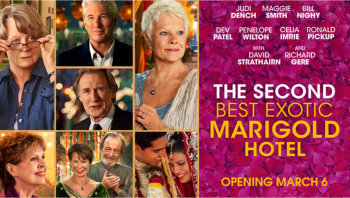 Marigold #2 DID NOT adhere to the 8 person and 3-star rule. They had fifteen people, all scrambling for their moment in a mediocre soap opera storyline. Tom Wilkinson died in the original film so his star power was replaced in the sequel by actor Richard Gere, who in my estimation looked as lost in the story line as I was. Sonny (Dave Patel), the hotel’s owner, was upgraded to star status in the sequel. From the opening moment of the film, he mugged, rolled his eyes and yelled his way through most of his scenes. In the original, he was likable; in the sequel he was quirky. Smith and Dench managed (as the producers knew they would) to turn gush into gold.
Marigold #2 DID NOT adhere to the 8 person and 3-star rule. They had fifteen people, all scrambling for their moment in a mediocre soap opera storyline. Tom Wilkinson died in the original film so his star power was replaced in the sequel by actor Richard Gere, who in my estimation looked as lost in the story line as I was. Sonny (Dave Patel), the hotel’s owner, was upgraded to star status in the sequel. From the opening moment of the film, he mugged, rolled his eyes and yelled his way through most of his scenes. In the original, he was likable; in the sequel he was quirky. Smith and Dench managed (as the producers knew they would) to turn gush into gold.
All in all though, Marigold #2 lives up to its name—Second Best. The film’s name could have been from Hollywood to Bollywood because the film starts off in Hollywood and ends the film by throwing us a big ballyhoo Indian dance number so typical of Bollywood type productions.
Wrap up: The producers will make tons of money off this sequel even though it doesn’t live up to the quality of the original. In fact, it might even end up making more money than the original.
Sequels work more times in the bucks department than they do in the critical department. In fact, the new novel of mine just out entitled MURDER IMPOSSIBLE is a sequel to my book TEDDY BEAR MURDERS. It is already out-grossing its predecessor.
April 2, 2015
Festivals
Palm Springs, California, where I live and this blog originates is getting to be the home of the phrase “Film Festival.” The big one is the first two weeks of January and it is called “The Palm Springs International Film Festival.” I have written about it and other festivals that call this resort city home. It seems that about every week there is a festival of some kind. Just a week or so ago we had the Native American Film Festival. This past long weekend (Thursday through Monday) we had the American Documentary Film Festival. I think if one retires in Palm Springs, one could have his or her total retirement filled with and about Film.
This latest film festival was organized four years ago by a group of dedicated film makers, most notably Joel Douglas, the youngest son of actor Kirk Douglas and brother to actor Michael Douglas. Their first celebrity centerpiece was Oliver Stone. This year it is Peter Bogdanovitch. He kicked off opening night with a documentary film of his followed by the usual and expected Q and A. According to the local newspaper, it was a sterling event for one and all.
I had wanted to go to the opening night showing at the Native American Film Festival a couple of weeks back because they showed a documentary concerning a very outspoken male to female transgender person. I unfortunately missed it but hope to catch it sometime somewhere else.
If one is going to become a Festival jockey in Palm Springs, I think you must be retired or have a lot of free time—not to mention a healthy bank account. Entrance fees to festivals I’ve noticed keep going up every year and are no giveaway. Therefore, at this present festival—The American Documentary Film Festival, I limited myself to seeing only two films. I am sure there were others quite worthy of viewing but I had to keep an eye on my wallet.
I am intrigued by documentary film making. To me, it is writing with a camera. With a real documentary, you don’t rehearse, you don’t have people having to stand in certain places, and perform in certain ways. You don’t write their dialogue for them. Basically one is supposed to be getting a pure slice of life. Some succeed at this much more than others.
I have watched many documentary films on TV as well as via Netflix. One of the best I have seen recently was on Netflix and it was called PRISONER OF PARADISE. This documentary chronicles the life of Kurt Gerron, a German Jew who rose to prominence as an actor and director in prewar Germany. You all know him because he played the guy in the top hat who was the MC at the club where Marlene Dietrich performed in the well known 1930 film BLUE ANGEL. All his European friends in Hollywood tried to get him to leave Germany and join them in Tinsel Town. He refused because he was sure he was so well known and loved in Germany that the Nazis dared not lay a hand on him. He was quite wrong as he ended up being put to death in a concentration camp the last day the “baths” and crematoriums were used. A fresh reminder that we should never forgot what happened to all those six million people who perished. Each for sure had a story that would have made a great documentary.
At the documentary film festival this week, I saw two film. The first was JESUS TOWN, USA and the second was PRISONER TERMINAL.
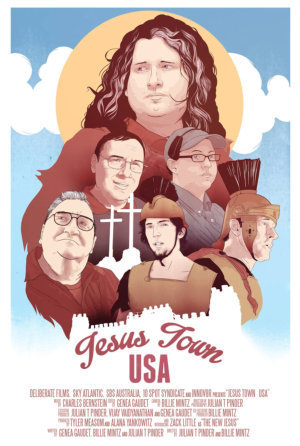 JESUS TOWN, USA. This could be called “American Fellini” in that it zooms in on some pretty unusual people, who obviously believe that others unlike themselves are all going “directly to hell.” The background for all this falderal is the annual passion pageant depicting the life of Jesus which takes place in Lawton, Oklahoma. A viewing of this film will easily explain why Oklahoma is one of the reddest Republican states in the nation. These people here “pray it out with Jesus” over their casting dilemmas and anything that pops up in their daily lives whether it be bowling or which candy bar or burger to buy. Just ask Jesus.
JESUS TOWN, USA. This could be called “American Fellini” in that it zooms in on some pretty unusual people, who obviously believe that others unlike themselves are all going “directly to hell.” The background for all this falderal is the annual passion pageant depicting the life of Jesus which takes place in Lawton, Oklahoma. A viewing of this film will easily explain why Oklahoma is one of the reddest Republican states in the nation. These people here “pray it out with Jesus” over their casting dilemmas and anything that pops up in their daily lives whether it be bowling or which candy bar or burger to buy. Just ask Jesus.
This spectacle began in the 1930s and in the olden days drew over 200,000 people. Many citizens of Lawton have been performing in this pageant for almost half a century—this includes Darlene who plays the Virgin Mary. Nowadays, their audience is down to a handful. The people of the town who operate this show are convinced they are winning souls for Jesus. “Lots of people out there are going directly to hell and it’s our duty to save them.”
The crux of the film is that after years and years of playing Jesus, the principal performer retires. The community has to go into great deliberation over who will now play Jesus. With all sorts of talks with Jesus himself, God and their people who have played biblical characters for up to 50 years, they come up with a very unlikely candidate. The new Jesus is Zack, a round-faced, chubby young man with a Whataburger and Slurpee habit. The town goes into rehearsal and things look like they’re running along just fine. That is until Zack is invited to go bowling with the young man who is playing the disciple Judas. Zack lets it slip that he isn’t a Christian at all. He converted to Buddhism the previous year. He had been working at the hospital and ran into a Buddhist priest administering to some Japanese tourists who had gotten sick.
Judas tells his grandfather who says that all Buddhist and “them foreign types” are all going to go directly to hell. This calamitous news travels fast and the town has a prayer meeting at the church. . They go into deep talks with the real Jesus over if it is possible for a Buddhist to play Jesus. . Could the Passion Play have a Christ who wasn’t a Christian? Would the people of the area come to see a Buddhist Jesus? Did they run Zack out of town? Was the Passion Play somehow saved? For answers to these burning questions, look for JESUS TOWN, USA soon on Showtime.
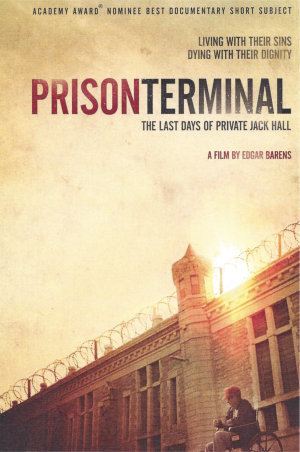 PRISONER TERMINAL: The Last Days of Jack Hall. This 40-minute documentary is made by a very talented film maker by the name of Edgar A. Barens from Chicago. This film was up for an Oscar this year and after having viewed it, I wish it had won. It is an excellent film and Edgar does do a great job. It is hard to watch at time but this is what make it great film making.
PRISONER TERMINAL: The Last Days of Jack Hall. This 40-minute documentary is made by a very talented film maker by the name of Edgar A. Barens from Chicago. This film was up for an Oscar this year and after having viewed it, I wish it had won. It is an excellent film and Edgar does do a great job. It is hard to watch at time but this is what make it great film making.
This is an inspiring and deeply moving documentary. It is filmed in a prison and concerns the last days of an 82-year old prisoner whose life is slowly ebbing away. He is a decorated veteran of World War II who could not adjust to civilian life because he had witnessed too much death and suffering. He turned to alcohol and drugs and ended up murdering the drug dealer who caused the death of his son. He is at the end of his years but through an unusual program in his prison is allowed to die with dignity . He is cared for by orderlies who nurture Jack, bathe him and stay with him until his dying breath. It is all beautifully done and a testament to how men who have murdered become the men they thought they could never be.
This film is just plain beautiful. No other way to describe it. I had the opportunity to meet the film maker of this documentary. We sat together at the showing of JesusTown USA. He is a very likable person and his good qualities are quite evident in this film. If you have HBO, you can view this film now.
So there you have it until the next Festival. Just looked up the schedule and Palm Springs has the FILM NOIR FILM FESTIVAL and the INTERNATIIONAL SHORT FILM FESTIVAL coming up soon. Can you believe it?
March 26, 2015
Good Story Telling
In the recent couple of months, I have read four books. One was a biography of a famous writer. Its 500 plus pages read like a psychiatrist’s notebook. The second book had a decent story line but it was totally overwritten. The third book was on the afterlife. It read like fiction even though the author swore she had experience all the things she reported. The fourth was a piece of fluff that was fun for a bit but got tedious and ran out of steam by the time the ending finally came around.
I’m not trying to say that all books are bad unless they are written by me. Far from it. I have in the last year read some very good books. I just take the books mentioned in the preceding paragraph to disclose my most recent readings.
Also I went to see a movie recently and they showed seven previews of coming attractions before the featured film. I couldn’t believe it. All seven melded together as though they were continuations of one another. Boom, bang, pow, fights, car chases, the supernatural and superheroes. None made me want to see them and all made me wonder what happened to the art of story telling. I also kind of got the same feeling after reading those four books recently.
What is story telling? It consists of a tantalizing idea with compelling characters who present to the reader (or listener) a set of valid and interesting motives, goals and conflicts. This is the crux of the work cut out for you if you intend to tell people stories—even if it’s no more than about your trip to the supermarket yesterday.
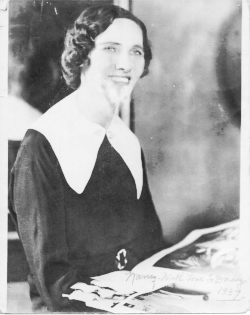
My aunt, the poetess Nanny Lou Whitfield, who was the best story teller in our family.
A good story teller will provide you with all sorts of facts. A non-story teller will tell you almost nothing.
Question: What did you do yesterday?
Non-story teller: Nothing much. Went to the supermarket.
Story teller: Went to the supermarket. I was, as is my custom, reading the sales sheet when a man walked up to me and said, “Are you playing the Monopoly prize game? I sniffed something interesting and I replied with a thankful-looking smile, “”Yes, I am.” “Well, I’m not so you can have the pieces they gave me.” I thanked him as he walked away. I checked out the little bits of paper and was happy to find that I had won a free can of ravioli.
See, there you have it. With some people, you have to ask a dozen questions to get any information out of them. In fact, you have to pull it out of them. On the other hand, with story tellers you never have to. They’ll always come up with interesting characters and plot points. Yet believe it or not, some non-story tellers want to become writers. What are their chances at becoming interesting writers or conversationalists? Very little if you ask me. They simply must give you much more than yes, no or at best one or two word answers.
Here are some tips to help you in your writing and story telling.
The most important thing is to always know your ending. It must be precise and concise. So many people start writing and think they will come up with the ending later on. Writer’s block comes about when you don’t know where you’re going. Always know where you’re headed in your story line. Without doing so, you’re trying to explore new territory without a compass.
Who is your audience? This is extremely important. Write to them—not yourself. You may think something is terrifically interesting or funny but what about your readers and listeners? Tell fairy tales to your grandchildren but not to your friends at your favorite pub. Know who your public is before you write the first line or open your mouth. Who is your audience?
Don’t be preachy. Leave that for the minister at church. Lecturing people is hardly what one could call effective story telling—unless you attach a lot of human interest yarns.
Conflict is plot and that is the heart and soul of your writing or talking. Clashes occur when your hero is thwarted in his or her effort to accomplish a certain something, or someone throws tacks in his or her path. Generally struggles arise when people’s value systems are different from that of your hero’s. It could be as simple as your lead doesn’t smoke and someone else around him is a big smoker. How does he solve this? Good story. What makes for decent conflict and plot is to give your characters decided opinions on things. Passive characters are never interesting. We can’t root for someone if we don’t know precisely what they stand for.
If you have not done a good job of numbers one through four, you probably will abandon ship on your project. Maybe you will persevere and think all will work out when you edit your work. You can try that but if it takes tons of time and you’re not getting anywhere, give up on this project. Learn from it and start another. I guarantee your next one will be better.
Remember, it’s not story telling until it gets out of your head. How many people talk about writing a book but it never gets written? Talking about it is zero in the story-telling department.
One thing you must properly deal with in your story telling and that is coincidences—accidental occurrences. Use these to your heart’s content as a way of causing conflict in a person’s life. (How did I know my ex-wife would be at the same meeting? I knew the minute I started my speech she would begin heckling me.) Any happenstance that causes problems for your hero can only help your plot gallop along. However, and be very careful, a coincidence to get your hero out of conflict is not good and should be used only on the rarest occasion. (I was about to shoot myself over my dire financial situation and that is when the doorbell rang. It was the people from Publishers Clearing House presenting me with a check for fourteen million dollars. I, of course, did not pull the trigger. )
 So, there you have what can be called the rules for good story telling. I’ll close this out with some advice by the noted author Steven King.
So, there you have what can be called the rules for good story telling. I’ll close this out with some advice by the noted author Steven King.
“There are books full of great writing that don’t have very good stories. Read sometimes for the story… don’t be like the book-snobs who won’t do that. Read sometimes for the words–the language. Don’t be like the play-it-safers who won’t do that. But when you find a book that has both a good story and good words, treasure that book.”
― Stephen King
March 19, 2015
Humor
Humor is your brain having a good time.
Authors who write material of any kind (outside of textbooks and the like) need to introduce a little humor into their writing. The same thing can be said for people in general. It doesn’t hurt to infuse our writing and our lives with a bit of amusing chatter or rhetoric.
I’ve found three types of people when it comes to humor. Group 1 is what we think of as naturally funny. I had an aunt who fit that category, also a niece and a couple of close friends. I also tend to be a part of this group or so I have been told. Analyzing myself and these other people, I’d say that instead of just naturally being funny, we have found by observation how to be witty. In other words, I think humor can be learned as though it were a special grammar. We do not have a fun gene that allows us to comment on the fads and foibles of the moment. In my case, up until I hit puberty I was not funny in the least. Then I found that I wasn’t all that popular with my peers and I saw I had to do something fast or I was going to be labeled a bona-fide dullard.
I discovered rather quickly that if I always told something unusual or absurd about an ordinary situation, it would tickle the funny bones of my friends. You see, they were expecting the ordinary and got the unordinary. “I saw a cross-eyed chicken and it was walking like a drunk across the road.” Not big time humor, but for a 14 year-old in Okolona, Mississippi, it got some chuckles from my cohorts. So, over time I improved and became better at off-base stories.
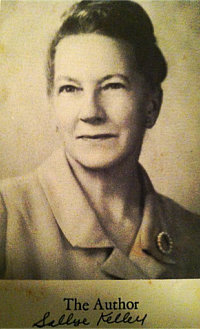 When I began writing, I dropped this knack and swapped it for somberness. I didn’t know it but my writing was dull. My father’s first cousin was the writer Sally Kelley and I used to visit her when I was growing up. She wrote short stories for all sorts of national magazines. She read some of my stuff once and promptly told me to lighten up. Of course I didn’t listen. I should have seen that even though her stories were stark, human tales, she never left out a bit of humor.
When I began writing, I dropped this knack and swapped it for somberness. I didn’t know it but my writing was dull. My father’s first cousin was the writer Sally Kelley and I used to visit her when I was growing up. She wrote short stories for all sorts of national magazines. She read some of my stuff once and promptly told me to lighten up. Of course I didn’t listen. I should have seen that even though her stories were stark, human tales, she never left out a bit of humor.
This does not mean that you have to turn every calamitous thing you write or say into a comedy. You just have to treat it like successful Sally Kelley did—have a touch of humor every now and then. Shakespeare was great at this in his tragedy plays. (EX. The nurse in Romeo and Juliet.) Also photos or drawings can be exaggerated for a humorous effect. Caricatures would be an example.
I also noticed that by adding an unusual or absurd element to ordinary occurrences, I could conjure up some humor. EX. I had a collision in my car. I ran into Rosie, the horse drawing the local tourist carriage. This isn’t hilarious but it does present a visual picture to your listener or reader—and that’s what humor is all about.
Another humorous thing is repetition—the same event happening over and over. In the film GROUNDHOG DAY, it is the premise of the movie. This guy wakes up every morning and it’s the same day over and over for the entire movie. It builds and gets funnier and funnier. One more example. If a guy trips over the lawnmower once it’s not necessarily funny. The second time it is funny and the third could be hilarious.
A variation of this is when we’re telling a joke. You always have three instances of the same event. It could be three mothers telling something about their daughters. The first says her daughter married a doctor, the second says her daughter married a lawyer—and then the third says her daughter married a jerk—but his name is Rockefeller. You can have three of anything happening. Ex. A fat man comes into a bar and asks for a beer. A thin man comes into a bar and asks for a beer. Now, you finish the last one in the series and add a kicker of some sort. I’ll help you. A skeleton comes into a bar and asks for a beer—and a mop.
One other big resource for humor is the art of playing on words and puns. One word can have many meanings and thus its misuse brings laughter. EX. I used to be a banker but I lost interest. I’m reading a book about anti-gravity. It’s impossible to put down.
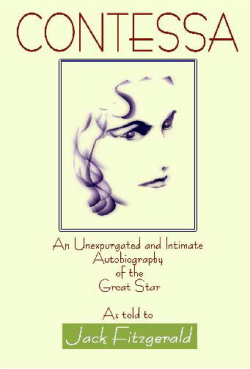
The key to successful humor is to be a little off base and tweak someone or something that is familiar. Most of your best comedians and humorists do exactly that. Think of Oscar Wilde (There are two tragedies in life: not getting what you want and getting what you want.) Mae West (When I’m good I’m very, very good, but when I’m bad, I’m better.) Fran Lebowitz (I never met anyone who didn’t have a very smart child. What happens to these children, you wonder, when they reach adulthood?) and George Carlin (Have you ever noticed that anybody driving slower than you is an idiot, and anyone going faster than you is a maniac?) This sort of humor is just fine if you’re talking politics or about life in general or concerning some well known personality. But do not use your friends as the butt of your put-down jokes. They won’t find it funny and no one else will laugh either and they could sue you. You most likely will end up laughing at your own jokes and you know how most people feel about that.
Now I have to put up or shut up. Here is a passage from my book CONTESSA. In it, the title character’s first job in show business is doing burlesque at a whore house in Havana, Cuba. She has just come out on stage for the very first time.
I smiled and in an all-knowing way, began my monologue: “Hello there. I’m Contessa—a girl who looks good in anything I take off.”
The audience applauded and cheered. The hecklers never even got started—thank goodness! I went on:
“A wife! You know what that is: the bitter half—a disease that’s easier to catch than get rid of. A woman who whines you around her little finger. You know what a widow is, don’t you? A woman who no longer finds fault with her husband. There are two types of wives: the bereaved and the relieved. I notice you, sir, staring at my—blond hair—the outstanding contribution of chemistry to the world. —My evening gown? It’s by Lo and Behold! This dress picks up everything—mainly men!”
A group of sailors shouted and whistled.
“Men! You’re the only animal that can be skinned more than once. You have three ages: underage, overage and average. I’m a modern girl myself—a woman who has visible means of support. I have more clothes on when I go to bed than when I go to work.”
I used just about all the available tricks for humor in the preceding paragraphs from CONTESSA. I urge you to do the same in your writing. In fact, if you’re a writer, take something you’ve written and see if it contains any humor. If not, change it around and add something witty or clever. It can only improve what you have written.
Oh, I mentioned that there were three groups of people when it comes to humor. I have already gone into detail on Group 1. In Group 2, you find the people who think they are funny but aren’t. The problem is they’ve watched too much late-night TV talk show repartee. They think a one-liner has to follow anything anyone says. They generally laugh at their own jokes. Aargh! What they fail to realize is that their late-night idols hire professional comedy writers for big bucks. Your friend who is running his or her own private talk show has no paid writers and has never taken the time to analyze how real humor is structured. He or she just gas off their unfunny attempts at humor and expect people to laugh. They generally don’t. That person ends up laughing at his or her own jokes. Ugh!
Group 3 consists of people who think of themselves as having high wit that only they and a few of their honored friends can fully appreciate. They’re the ones who give you a pursed-lip smile after one of their pronouncements. EX. A sourpuss friend of mine was in the hospital and had to miss an acquaintance’s party. He asked a friend, “How many people were there?” The guy answered, “Thirty.” Sourpuss replied, “He doesn’t know thirty people.” So all in all, Group 3 is the insult joke. Joan Rivers was a specialist at this but she had professional writers. Your friends who belong to Group 3 probably don’t and thus they just look and sound like sourpusses. How funny is that?
So, there you have it. Which group do you belong to?
March 12, 2015
ENCORE: Name a Year
On my way to visit a niece in Louisiana several years back, I had a couple of hours layover at the Los Angeles airport. The waiting facilities were torn up and so people who were hanging around for their flights were all bunched together. The place was a madhouse and I couldn’t find a vacant place to sit. Finally an opening appeared when someone left. I ran and quickly plopped into the seat.
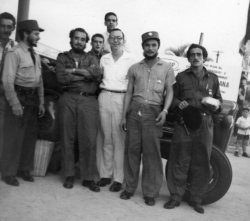
Jack in the Cuban revolution in 1958.
Next to me was a young man of about twenty-five and he too was killing time. This meant he had all sorts of electronic devices that he fiddled with—laptop computer, iPod, smart phone and a video game or two. Generally I am not a talky type although my friends will be surprised to hear me say that because to them I’m the quintessential alpha personality you might find. I will admit though, if I start talking it will develop into a real gab fest—but what I’m saying, is I’m not one of those professionally needy people who HAS to talk. I can do without it. I am not compelled to talk.
In this particular case, I plead guilty to opening the conversation. The young man was texting and his thumbs were performing keyboard magic. I simply cannot accomplish such a feat and am always amazed by how people do it. He looked up and gave me a non-plus look. This meant he didn’t say anything but at the same time was curious as to why I was watching him.
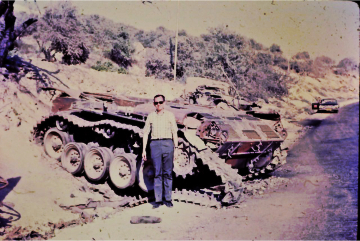
Jack and destroyed tank in 7-day war in Israel 1967.
I felt I had to say something so I commented on how amazed I was that he could actually write a message with his thumbs—and do it so rapidly. That did it. He began talking and asking me questions. You know it only takes about ten questions before the other person almost knows your Social Security number.
By the end of his tenth question, he knew I had lived in Paris, I had founded the Paris English Theatre, I was a writer of screenplays and novels, and that I had been all over the world. He also found out that even though I had the trappings of being rich and famous, I wasn’t. Somehow, I explained to him, success had eluded me as far as the brass ring went.
He informed me that in no way could he do so much work, like I did in writing, and get so little out of it. He was interested in making a bundle of bucks as soon as possible. I told him I thought that was nice but one could have a good time out of life without fame and success. I added that I thought one of our problems in this country at the moment is that everyone wants to be rich and famous. He blinked his eyes as though he had no idea what I was talking about.
I told him that every year I had lived, I had put a lot of fascinating events into each one—some good and some not so good. A lot of that living I continued had nothing to do with fame and big bucks. And to top it off, I told him I wouldn’t swap any one of the years I have lived.
That sounded like too pat of an answer for him and I could tell he thought it was just a convenient happy-face way to explain away my being old and not Donald Trump.
“Name a year,” I said.
“Okay, what about 1987? That was the year I was born,” he said glibly
I had to think a bit but I soon said “Not as exciting as most but still not bad. I had two small roles in movies, did three TV commercials, a play of mine was produced in Los Angeles, I went to Mexico and Guatemala, spent a month in Paris with friends, and got a part-time job teaching theater at a university in Los Angeles. See, none of that made me rich or famous but still I had a fascinating year. Name another year.”
“What about 1958?”

Cover of Jack’s book CONTESSA.
“Very interesting year,” I said. “I graduated from college with my BA and went to live in Havana, Cuba, to teach English. Had a great time as Havana had to be the fun capital of our hemisphere at that time. Fidel Castro came along , I found myself in a revolution which turned very dangerous very quickly. Shortly I was forced to leave Cuba. What an exciting year that was. I managed to use all my adventures in a book I wrote called CONTESSA.”
I don’t know if I convinced him of very much with this little game of ours, but before his flight was announced and he left, I had sold him a copy of my book CONTESSA, which he bought on the spot from Amazon.com via his laptop.
In fact we’re all richer than we actually give ourselves credit for—that is if we have gotten out and lived. As I say at the top of this blog, “Life is just a giant hors d’oeuvre tray for me.” I hope I convinced that guy just a tiny bit that happiness isn’t the exclusive playmate of fame and fortune. There’s a lot of fascinating living going on out there. Don’t let it pass you by because you can’t see the forest for the trees. Zestful living is happiness for me. And if you’re going to be a writer, zestful living is a necessity.
The reviews are in! The reviews for Jack’s newest book, Murder Impossible, are rolling in. You can read them here.

